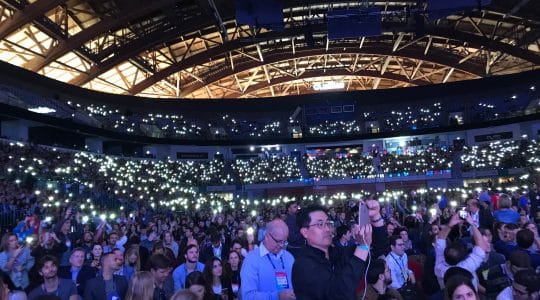Machine learning is one of the most hyped fields of recent times. The topic is subject to intense theoretical research, practical industrial implementations as well as a few not-so justifiable fears (most of them being about robots killing all humans).
Machine learning is usually defined as “a type of artificial intelligence (AI) that provides computers with the ability to do certain tasks, such as recognition, diagnosis, planning, robot control, prediction, etc., without being explicitly programed. It focuses on the development of algorithms that can teach themselves to grow and change when exposed to new data.”
This brings us to the question: how is machine learning used in the mobile advertising industry? We sat down with two data scientists from AppLift, Dr. Florian Hoppe and Bruno Wozniak, to understand how machine learning algorithms can help drive campaigns more efficiently and cost-effectively.
Here are three major examples: Real-Time Bidding (RTB), lookalike targeting and user data enhancement.
1.DSPs Use Machine Learning Algorithms to Bid on RTB Traffic
The first area of mobile advertising which can be improved by machine learning (ML) is Real-Time Bidding (RTB) traffic. In an RTB environment, Demand-Side Platforms (DSPs) need to determine the optimal amount to bid on every single specific impression. Most RTB-enabled exchanges will only allow a maximum response latency of 100 milliseconds, meaning that a data-driven assessment of the impression has to be generated within an extremely short amount of time.
In order to determine how much to bid, the algorithm needs to assess the probability of the impression resulting in good performance metrics, such as click-through rate (CTR), conversion/install rate (CR/IR), and even post-install events that enable to approximate Lifetime Value (LTV). This assessment is done programmatically, utilizing data provided with the impression, either from the publisher or from a data management platform (DMP), as well as first party data from the advertiser as input.
ML algorithms take historical data samples to estimate future performance. For instance, they can determine that a banner coming from a specific ISP, operating system, website, demographic, etc. has a 2% likelihood of resulting in a conversion. The hardest part of using historical data samples is knowing which ones to take (determining time span as well as a myriad of other attributes). Algorithms are much more efficient than humans at evaluating exactly which attributes of impressions are good predictors of better ad performance, as it can look at all of them simultaneously, whereas a human is rather limited in finding patterns in historical data sets of ad traffic.
Setting up the ML algorithms remains the hardest part as data scientists need to make smart decisions on a lot of variables within the algorithm, such as which method to use (e.g. logistic/Poisson regression, Bayesian Bandit; see whole list here), which length of time span to allocate in order to create the historical data set, as well as which encoding scheme to present the impressions to the algorithm with.
2. Segments for Lookalike Targeting Are Determined With Machine Learning Algorithms
The second field of mobile advertising where machine learning algorithms come to serve is lookalike audience clustering and targeting. Lookalike audiences became better known through Facebook, whose extensive first-party data made the functionality extremely powerful.
Today, most ad networks and exchanges offer granular targeting options to buyers, at least at the device level. You can for instance show ads to Android users living in the Chicago area. The hard part is knowing which cluster, or set of attributes, is relevant to target for a specific objective. The role of ML algorithms is to help define the best audience clusters, as defined by a specific set of attributes, in order to target similar – lookalike – clusters.
More specifically, ML algorithms will determine, out of a wide set of available attributes, which ones are the most relevant in order to reach a certain objective, thereby creating an audience cluster. To take a straightforward example, they will find out that females above 30 are more likely to finish a game tutorial. Diving even a bit deeper, ML algorithms will derive rules to automatically assign a new user to a defined group, and ultimately predict how this user will react to given ads. With both clusters and the rules for allocating them users defined, lookalike targeting can be implemented in order to show specific ads only to the users with the highest likelihood of showing interest in the advertised product.
3. DMPs Use Machine Learning Algorithms to Improve User Data
The third area where machine learning algorithm help improve mobile advertising is impression data enhancement for data management platforms (DMPs). In an RTB environment, impressions usually come together with user and device data from the publisher level. The latter can be more or less extensive depending on the extent of the data collected by the publisher. However, it is seldom sufficient for buyers to make an informed buying decision, especially in a demanding, programmatic environment. For instance, not many publishers are able to offer demographic data about the users (only Facebook and a few others do), but this type of data is essential to buyers. This is where DMPs come in, enriching and augmenting the supply-side data to give a better picture to the demand side of what they’re bidding over.
In this context, machine learning algorithms serve to improve the buying decision by enriching user data for each impression. Using dynamically-created statistical models, they derive additional, relevant information about users from third-party data sets. This third-party data can either be provided directly by the publisher (device, app or mobile website the user is in), or can come from an external data set (user reviews).
More specifically, by distilling statistical cross-correlations from third-party data, it is then possible for DMPs to infer otherwise unknown attributes, such as user demographics, which are crucial for targeting. Ultimately, algorithms help cope with the inherent inaccuracy of such information by calculating the probability that a given impression attribute can be used to derive additional attributes which are then more specific and more relevant to the advertiser. For example, they can calculate the likelihood for a user to be male, under 21 and a frequent player of strategy games.
With the help of machine learning algorithms, DMPs can then help DSPs improve pricing a bid over a specific impression.
Machine learning algorithms play a crucial role in the mobile RTB ecosystem, which is a growing piece of the mobile and online advertising pie. The common element to all of the above use cases is the fact that algorithms enable the scalable automation of predictions based on historical data. Their ultimate strength is to enable mobile advertisers, along with all other players of the adtech ecosystem, to overcome the limitations of aggregate metrics analysis for decision making. Instead, they make it possible to optimize at the most granular level possible: every single user interaction.
Do you have questions or would like to share your experience of working with machine learning algorithms? Let us know in the comments!
Note: A version of this article was originally published on the AppLift blog.
Like this article? Sign up for our blog digest emails.
Author
Becky is the Senior Content Marketing Manager at TUNE. Before TUNE, she handled content strategy and marketing communications at several tech startups in the Bay Area. Becky received her bachelor's degree in English from Wake Forest University. After a decade in San Francisco and Seattle, she has returned home to Charleston, SC, where you can find her strolling through Hampton Park with her pup and enjoying the simple things between adventures with friends and family.







Great article! This is really fascinating stuff. The third point was especially interesting. Are there any measures or checks of how accurate the estimated demographic data from the DMPs is? e.g. If the algorithm is telling you that you’re targeting a 21 year old male, is there any way to know after the fact that it was in-fact a male or a 21 year old that saw that impression (maybe by attributing a specific install/user to an impression?)?
Hey Alex, we’re glad you liked the article.
When talking about DMPs, we can differentiate two types of data analysis:
Probabilistic Data and Deterministic Data
Deterministic Data DMPs typically get their data from validated audience set: Telecom companies for example, which share their customer data anonymized with DMPs, Retail members loyalty data being shared with a DMP – both of these can be associated with a unique device identifier (given that the same user/s are crossed at some point).
Probabilistic Data is data exhumed from various sources, analyzed and categorized by contextual or other means to segment audiences.
Crossing probabilistic data sets with deterministic sets is probably the closest possible means to validate accuracy of data – however , since we are talking big data statistical analysis – there will never be a 100% accuracy, but DMPs aspire for an accuracy level that is close to 100%.
When referring programmatic media buying and machine learning algorithms with the additional DMP layer for better forecasting and targeting , most DSPs use what is referred to as the Thompson Sampling algorithm approach (wiki it if you dare! 🙂 , which in plain words, refers to an ‘optimistic’ approach going with an “everything might work well” , testing everything before eliminating a certain mix of parameters and factors.
It’s interesting to see that most DSPs have patterns of buying, some peak once a day, some peak once every few minutes, testing every possible combination possible to try and build better data sets and segmentations to ‘learn’.
Cool stuff isn’t it? 😉
Thanks for the thorough answer! Very helpful – and super interesting. It’s crazy what can be done with big data.
I love the way of explained in article
Fantastic article! Great work Tune!
Adam – CEO, Kahuna – [email protected]